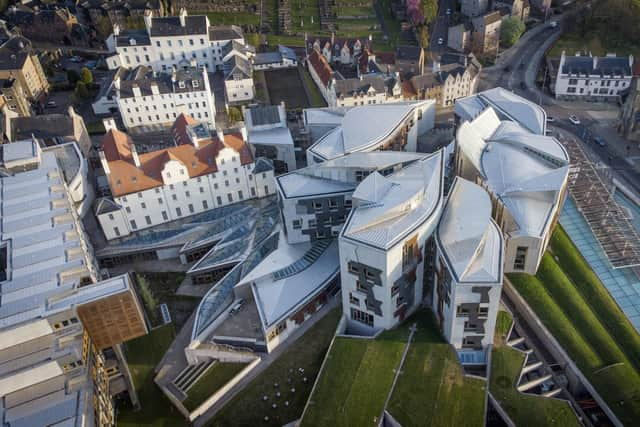Exclusive:Gender pay gap widens to record level at Holyrood body
The gender pay gap at several public sector organisations across Scotland has widened, with some high-profile employers, including the Scottish Parliament, posting record disparities in what women earn compared to their male counterparts.
An analysis by The Scotsman of data compiled under the UK Government’s gender pay gap reporting mechanism shows that in some sector employers, the median hourly pay gap – the difference in pay between the middle-ranking woman and the middle-ranking man in an organisation – has reached an all-time high.
Advertisement
Hide AdAdvertisement
Hide AdWhile the vast majority of Scottish public bodies are not required to report their pay gap under the UK regulations, and instead report under the public sector equality duty (PSED) in Scotland, the data posted by several organisations reveals some have regressed instead of making progress.
The Scottish Parliamentary Corporate Body (SPCB), the organisation responsible for the running of the nation’s devolved legislature, saw its gender pay gap increase for a third consecutive year, with the disparity now standing at a record high.
Its latest median hourly pay gap is 11.2 per cent, meaning that women employed by the body earn just 89 pence for every £1 that men earn. The median gap is up from 7.6 per cent the previous year, and almost three times higher than the first year it began reporting gender pay gap data, when it stood at 3.8 per cent. The median pay gap fell the following year to 2.9 per cent, and again in 2019/20 to 0.9 per cent. Since then, however, it has risen sharply.
The SPCB said the increase was “largely predicted” due to changes in the “median spine point” surrounding different pay grades for men and women. The body said in future years, the pay gap could decrease due to the median point for both men and women falling into the same grade.
The SPCB, which is chaired by presiding officer Alison Johnstone, and which includes three women – Scottish Labour’s Claire Baker, Maggie Chapman from the Scottish Greens, and the SNP’s Christine Grahame – among its elected members also reported slightly fewer women occupying the highest-paid jobs, down 0.8 percentage points to 54.2 per cent. By contrast, women were found to be “over-represented” in the lowest pay quartiles.


In an accompanying diversity monitoring and pay gap report, the SPCB said it would “investigate these disparities” to discover if there were any “unintended barriers” preventing women from achieving promotion.
It also noted it was committed to adopting policies and practices that contribute to “pursuing complete equity among staff”, adding: “We are reviewing our pay and reward arrangements with these commitments in mind and we expect future diversity pay gap reports to be reflective of the outcomes of this review.”
Elsewhere, women employed by the Scottish Children's Reporters Administration are still only earning 72p for every £1 that men earn, according to its latest filings. The executive non-departmental public body of the Scottish Government made only incremental progress over the period, with the median hourly gap closing slightly from 27.9 per cent to 27.5 per cent.
Advertisement
Hide AdAdvertisement
Hide AdSome 74.6 per cent of the highest paid jobs at the Stirling-based body are occupied by women. However, they also hold 94.2 per cent of the lowest-paid jobs. The respective figures for the previous year were 74.4 per cent and 95 per cent.


In a report accompanying the figures, Neil Hunter, the SCRA’s chief executive, accepted that while there had been some “marginal” progress made, the overall pay gap remained “high”. As part of a series of recommended actions, he has pledged to “reinvigorate” a leadership network initiative designed to equip female employees for management roles. The SCRA will also provide mentoring and career support for women across grades and age bands.
Highlands and Islands Airports Limited (HIAL), another executive non-departmental public body, has a median gap of 15 per cent, an improvement on the previous year’s figure 16.2 per cent, albeit still above the public sector average. In its own analysis of the figures, HIAL said the company was “on a journey to address equal pay”. It said that the business case of a new pay and grading model was submitted to the Government in 2020, but its approval, and the implementation of the new model, was “severely impacted” by the pandemic.
HIAL said during 2022/23, the cost-of-living crisis impacted pay discussions and “delayed any progress on the pay and grading review”.
Sportscotland’s median gap increased notably over the 12-month period, up from 11.6 per cent to 16.6 per cent. It described the gap as “significant”. Women employed by the Scottish Prison Service, a government executive agency, earn 84p for every £1 that men earn. The gap of 15.6 per cent is unchanged year on year.
Anna Ritchie Allan, executive director of Close the Gap, said: “These figures make for grim reading for women in Scotland, many of whom have been hardest hit by the cost-of-living crisis. Gender pay gap reporting has now been in place for five years, so the lack of progress is deeply frustrating.
“It’s easy for complacency to creep in, but tackling the gender pay gap requires more than vague commitments to equality and diversity. Persistent, targeted action is needed to address the structural barriers women face such as inflexible work, workplace sexism, and discriminatory attitudes about who’s best suited to different jobs.
“The figures also expose the lack of teeth in the current regulations. It’s clear that reporting alone isn’t creating change, and we need stronger regulations that compel employers to set out the action they’re taking to close their gender pay gap.”
National World, the publishers of The Scotsman, reported a median hourly pay gap of 9.2 per cent, down from 10.3 per cent.
Comments
Want to join the conversation? Please or to comment on this article.